Campaigns and Articles
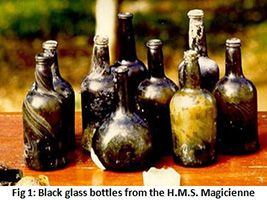
The H.M.S. Magicienne
Underwater archaeology in Mauritius first started in 1934, with the study of the shipwreck H.M.S. Magicienne. The H.M.S. Magicienne, a French frigate, was built in 1777 and was launched in 1778 at Toulon. Armed with 32 cannons, she formed part of the Franco-Spanish army in 1779. Captured by the British in 1781, her career ended on 23 August 1810, during the Naval Battle of Grand Port. The H.M.S. Magicienne was excavated in 1934 under the supervision of Harold Cholmley Mansfield Austen, who was then the director of railway and harbour engineer. With the help from helmet divers, part of the ship's hull and various artefacts were retrieved from a depth of 6 metres. Among these artefacts, today on display in the National History Museum of Mahebourg, there are several black glass bottles, some British coins, a rudder gudgeon, numerous iron cannons as well as various personal belongings of the crew.
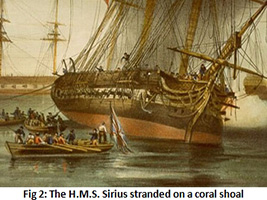
The H.M.S. Sirius: first period, 1964 - 1968
The archaeological activities started again in 1965 on the shipwreck of the British frigate, the H.M.S. Sirius, which sunk not far from the H.M.S. Magicienne in August 1810. Soon after the discovery of this shipwreck in 1964 by members of the Mauritius Underwater Group (MUG), an archaeological study was conducted on the rear section of the frigate. This research lasted several years and gave a lot of valuable information on historical aspects of the Naval Battle of Grand-Port. The aim of this first excavation was to identify the structures of the frigate and to locate interesting artefacts. A survey grid was established, in order to draw a site plan. Unfortunately, the cartography could never be completed as in 1968, the shipwreck was partially blown up with dynamite and various artefacts were lost or damaged. The whole rear section of the shipwreck was damaged by these explosions. However, a large part of the wreck remained intact protected by a thick layer of silt.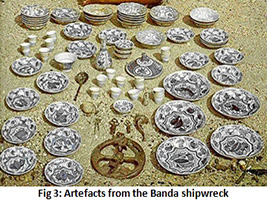
The Dutch East Indiaman Banda
Official underwater archaeology started in 1979 with the excavation of the Dutch East Indiaman shipwreck Banda by Jacques Dumas and Patrick Lizé. The Banda together with which the Geunieerde Provincien (United Provinces) was lost in a cyclone on the west coast of Mauritius in 1615. For the first time, a contract was established between the government and the archaeological team with the support of the UNESCO. The archaeological excavation lasted one year and enabled to draw a detailed site plan and retrieve intact some 90 pieces of Ming porcelain, a perfectly preserved mariner's astrolabe, several silver coins, a gold chain, some lead weights, a spoon and a compass.
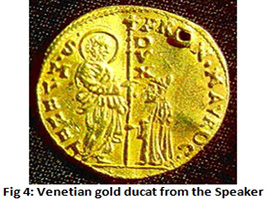
The Speaker: first period, 1979
During the same year and with the same team, a survey was successfully launched to locate the pirate ship Speaker which sank in 1702. Apart from the basic archaeological work (historical research, survey, identification of visible remains, cartography, excavation…) the following objects were found: hand bombs, a sundial, a Chinese padlock, two bronze statuettes, several clay pipes, 5 navigation dividers, 6 gold coins (Dinar and Ducat) and 14 silver coins (Austrian, Dutch, Ottoman, Spanish and Indian).
The French East Indiaman Saint Géran
In 1979 the French historian and underwater archaeologist, Jean Yves Blot, launched an excavation on the French East Indiaman, Saint Géran, which sank in August 1744. Following a complete archaeological study, various artefacts were retrieved, such as, a gold thimble and a gold buckle, silver cutleries, Spanish silver coins, millstones, a pistol as well as numerous wooden elements from the ship's rigging and hull. All these artefacts have undergone a conservation treatment and are currently on display at the National History Museum of Mahebourg.
The H.M.S. Sirius: second period, 1979-1987
In 1979 the archaeological activities were resumed on the H.M.S. Sirius but with very limited resources. A photographical study of the wreck enabled to sketch a first site plan. Furthermore one iron cannon was retrieved and placed in front of the Mauritius Underwater Group (MUG) headquarter, as a testimony of the glorious past of this frigate.
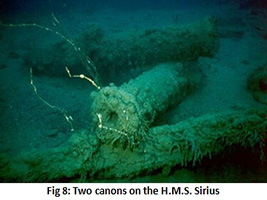
The H.M.S. Sirius: third period, 1987–1990
The third mission on the H.M.S. Sirius can be considered to be the first modern archaeological campaign in Mauritius. Archaeological work was done under the supervision of Yann von Arnim and Jean-Michel Langlois. Through this campaign a more precise cartography of the site was established, part of the wreck's hull was excavated and various maritime artefacts of the 19th century were retrieved. Out of the H.M.S. Sirius's armament of 34 cannons, only 18 were located. Post-field archaeological work such as data analysis and the setting up of an exhibition in the National History Museum of Mahebourg was done throughout the year 1988.
In 1989, before their departure to the Cargados Carajos Archipelago for a survey campaign, the Maritime Archaeological Research Group (M.A.R.), tested its electronic equipment over the H.M.S. Sirius wreck. As a result, a side scan sonar graph as well as a magnetometer chart of the site and its surroundings were obtained. A strong magnetic anomaly at an approximate distance of half a mile from the wreck was recorded and excavation revealed the presence of one of the H.M.S. Sirius's anchors. This anchor was retrieved from the silt and taken out of the water under the supervision of Chris Underwood, a British expert sent by the Mary Rose Trust. After a preliminary treatment in fresh water, it was handed over to the local authorities and is now on display at the Mahebourg National History Museum.
